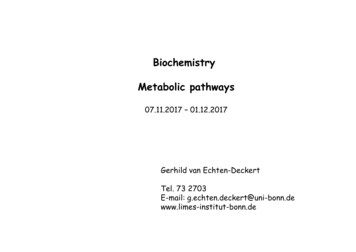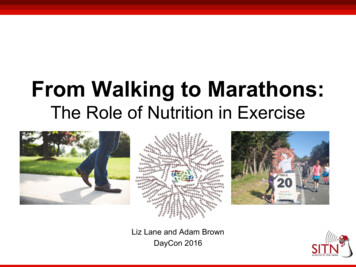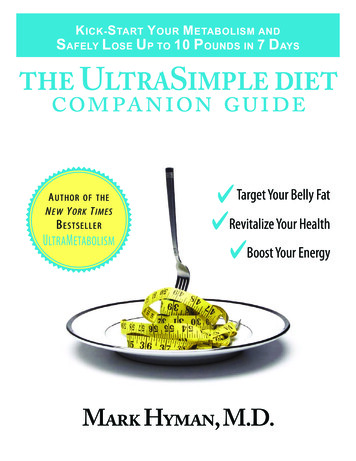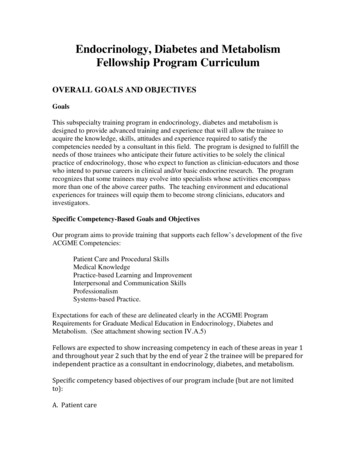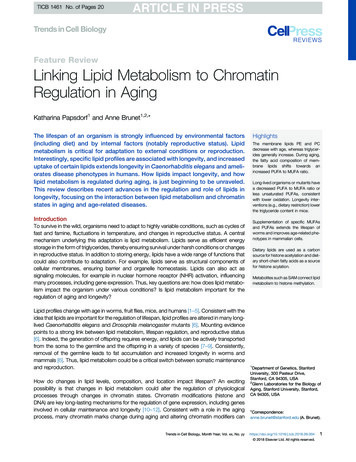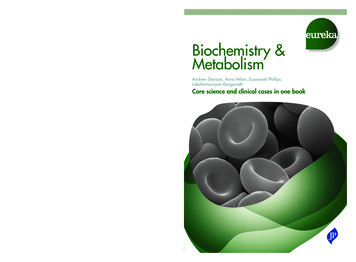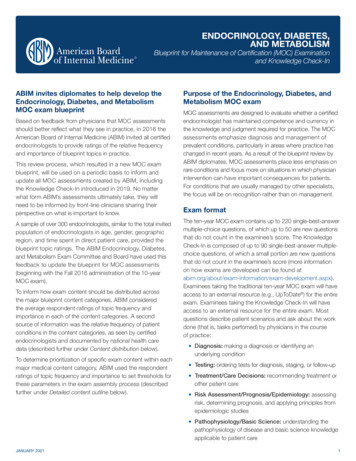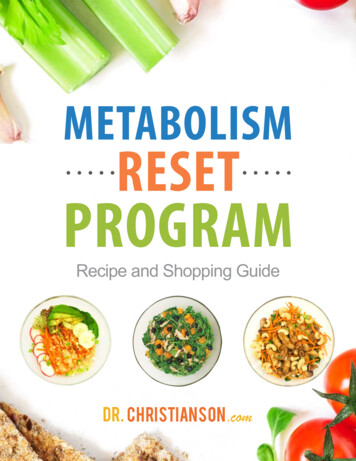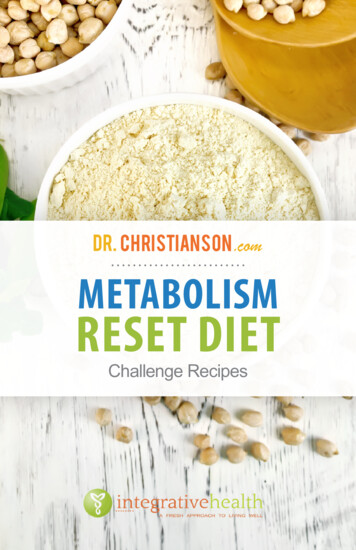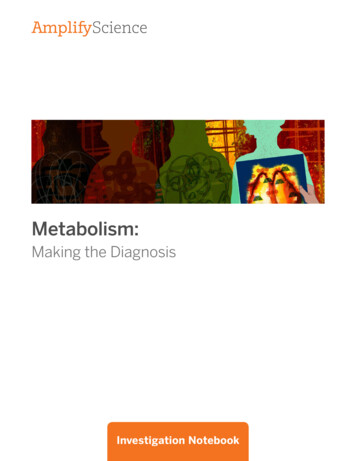
Transcription
Metabolism:Making the DiagnosisInvestigation Notebook
2018 by The Regents of the University of California. All rights reserved. No part of thispublication may be reproduced or transmitted in any form or by any means, electronic ormechanical, including photocopy, recording, or any information storage or retrieval system,without permission in writing from the publisher.Teachers purchasing this Investigation Notebook as part of a kit may reproduce the bookherein in sufficient quantities for classroom use only and not for resale.These materials are based upon work partially supported by the National ScienceFoundation under grant numbers DRL-1119584, DRL-1417939, ESI-0242733, ESI-0628272,and ESI-0822119. The Federal Government has certain rights in this material. Any opinions,findings, and conclusions or recommendations expressed in this material are those of theauthor(s) and do not necessarily reflect the views of the National Science Foundation.These materials are based upon work partially supported by the Institute of EducationSciences, U.S. Department of Education, through Grant R305A130610 to The Regentsof the University of California. The opinions expressed are those of the authors anddo not represent views of the Institute or the U.S. Department of Education.Developed by the Learning Design Group at the University of California,Berkeley’s Lawrence Hall of Science.Amplify.55 Washington Street, Suite 800Brooklyn, NY 112011-800-823-1969www.amplify.comMetabolism: Making the DiagnosisISBN: 978-1-64089-563-8AMP.NA18
Table of ContentsSafety Guidelines for Science InvestigationsMetabolism: Making the Diagnosis Unit Overview13Chapter 1: Molecules Needed by the CellsChapter Overview4Lesson 1.2: Welcome to Medical SchoolWarm-UpIntroducing the Metabolism SimulationHomework: Testing Diets in the Sim5678Lesson 1.3: Evaluating Initial Claims About ElisaWarm-UpReading “Molecules Cells Need”Modeling Molecules in a Healthy CellEvaluating New Evidence About ElisaEvaluating Claims About ElisaHomework: Exploring the Relative Scale of MoleculesHomework: Check Your Understanding910111213–14151617–18Chapter 2: Body SystemsChapter Overview19Lesson 2.1: Exploring the Classroom Body Systems ModelWarm-UpClassroom Body Systems ModelHomework: Making Observations in the Sim20212223–24Lesson 2.2: Patient Stories: Problems with Body SystemsWarm-UpReading Patient StoriesHomework: Using the Sim to Observe a Condition25262728Lesson 2.3: Learning More About a ConditionWarm-UpSecond Read of Patient Stories Articles293031Modeling a ConditionComparing Models to the SimHomework: Ideas About Elisa’s ConditionHomework: Reading “Meet a Scientist Who Grows New Cells”32333435
Table of Contents (continued)Lesson 2.4: Conducting Sim TestsWarm-UpMaking Comparisons with the SimWord Relationships: Discussing ConditionsHomework: Revising Inaccurate Models in the Modeling ToolLesson 2.6: Playing Guess My ModelWarm-UpPlaying the Guess My Model GameReflecting on the Guess My Model GameHomework: Reading Systems of the Human BodyLesson 2.7: Diagnosing ElisaWarm-UpAnalyzing Elisa's Test ResultsWriting an Argument to Support a DiagnosisHomework: Revising Your ArgumentHomework: Check Your 3–545556–57Chapter 3: Cellular RespirationChapter OverviewLesson 3.1: Learning About Energy Release in the BodyWarm-UpConsidering Claims About Energy ReleaseGathering Evidence from Heart and Breath RatesGathering Evidence from the SimRevising ClaimsHomework: Running Tests, Using the Sim5859606162636465–66Lesson 3.2: Exploring Chemical ReactionsWarm-UpObserving a Chemical ReactionObserving Cellular Respiration in the SimReflecting on Cellular RespirationHomework: Exploring Cellular Respiration676869707172Lesson 3.3: Cellular Respiration, Growth, and RepairWarm-UpReading “Growth and Repair”Modeling Cellular Growth and RepairWriting About ElisaHomework: Reading “The Big Climb”737475767778
Table of Contents (continued)Lesson 3.4: "Blood Doping: Messing with Metabolism to Win Races"Warm-UpReading “Blood Doping”Homework: Reading Odd Organisms and How They Get the Molecules They NeedLesson 3.5: Modeling Cellular Respiration in an Athlete’s BodyWarm-UpComparing a Healthy Body to an Athlete’s BodyModeling an Athlete’s BodySecond Read of “Blood Doping”Modeling an Athlete Who Is Blood DopingHomework: Getting a High Cellular Respiration Rate in the SimHomework: Check Your pter 4: Metabolism and Athletic PerformanceChapter Overview94Lesson 4.1: Going for Gold: A Cycling Champion’s StoryWarm-UpIntroducing the Science Seminar SequenceBlood Doping and High-Altitude TrainingEvaluating Example EvidenceEvaluating Evidence Cards9596979899100Lesson 4.2: Analyzing EvidenceWarm-UpExamining and Discussing Evidence About Jordan Jones's RaceCompare Jordan Jones' Pre-race Meals101102103104Lesson 4.3: The Science SeminarWarm-UpPreparing for the Science SeminarParticipating in the Science SeminarScience Seminar ObservationsHomework: Writing a Final ArgumentHomework: Check Your Understanding105106107108109110–112113Metabolism Glossary114–115
Safety Guidelines for Science Investigations1. F ollow instructions. Listen carefully to your teacher’s instructions. Ask questions if you don’tknow what to do.2. D on’t taste things. No tasting anything or putting it near your mouth unless your teacher says itis safe to do so.3. S mell substances like a chemist. When you smell a substance, don’t put your nose near it.Instead, gently move the air from above the substance to your nose. This is how chemists smellsubstances.4. P rotect your eyes. Wear safety goggles if something wet could splash into your eyes, if powder ordust might get in your eyes, or if something sharp could fly into your eyes.5. P rotect your hands. Wear gloves if you are working with materials or chemicals that could irritateyour skin.6. K eep your hands away from your face. Do not touch your face, mouth, ears, eyes, or nose whileworking with chemicals, plants, or animals.7. T ell your teacher if you have allergies. This will keep you safe and comfortable during scienceclass.8. B e calm and careful. Move carefully and slowly around the classroom. Save your outdoorbehavior for recess.9. R eport all spills, accidents, and injuries to your teacher. Tell your teacher if something spills,if there is an accident, or if someone gets injured.10. Avoid anything that could cause a burn. Allow your teacher to work with hot water or hotequipment.11. Wash your hands after class. Make sure to wash your hands thoroughly with soap and waterafter handling plants, animals, or science materials.1 2018 The Regents of the University of California. All rights reserved. Permission granted to photocopy for classroom use.
Name:Date:Metabolism: Making the DiagnosisUnit OverviewWelcome, medical students! You will be put to work right away to figure out whatthe trillions of cells in the body need in order to keep a human body healthy andable to function. Right from the start, you will be assigned a patient, Elisa, who is notfeeling well; it will be your job, after you learn more about how the body works, todiagnose what is wrong with your patient. Along the way, we will use the MetabolismSimulation to help you get to know what all the cells and systems of your body needto function and how the body works. Finally, we will also ask you to understand howa professional athlete's body works so well that he or she can do things that mostpeople cannot do.Metabolism 2018 The Regents of the University of California. All rights reserved. Permission granted to photocopy for classroom use.3
Name:Date:Chapter 1: Molecules Needed by the CellsChapter OverviewWelcome to medical school! Soon you’ll meet your first patient, Elisa. In order tohelp diagnose her condition, you are going to become an expert on metabolism—allthe things that occur inside our bodies to keep them functioning. Along with yourfellow medical students, you will be learning about the human body just as medicalprofessionals do: through investigating, reading, writing, and discussing. With yournew knowledge, you will be ready to explain what is going wrong inside Elisa’s bodythat is causing her to feel tired all the time.4Metabolism—Chapter 1 2018 The Regents of the University of California. All rights reserved. Permission granted to photocopy for classroom use.
Name:Date:Lesson 1.2: Welcome to Medical SchoolWelcome to your first day of medical training! Today, you’ll meet a patient, Elisa, and discusswhat might be causing her symptoms. To get started working toward a diagnosis, you’ll use theMetabolism Simulation to explore what happens inside a human body.Unit Question How do the trillions of cells in the human body get what they need to function, and what dothe cells do with the things they absorb?Chapter 1 Question Why does Elisa feel tired all the time?Vocabulary cells claim metabolismDigital Tools Metabolism Simulation (Healthy Body)Metabolism—Lesson 1.2 2018 The Regents of the University of California. All rights reserved. Permission granted to photocopy for classroom use.5
Name:Date:Warm-UpWhy do you think your new patient, Elisa, is feeling tired all the time? Explain your ideas.6Metabolism—Lesson 1.2—Activity 1 2018 The Regents of the University of California. All rights reserved. Permission granted to photocopy for classroom use.
Name:Date:Introducing the Metabolism SimulationPart 11. Launch the Metabolism Simulation.2. Select HEALTHY BODY from the menu.3. Select OBSERVE.4. Explore with your partner.5. Think about these questions: How does the Simulation work? What do you notice?Part 2Keep observing the Metabolism Simulation, but now focus on this question: What happens to the food and air that enter this healthy Simulation body?Part 3Consider the following question as you observe: Which molecules are entering the cell?Metabolism—Lesson 1.2—Activity 2 2018 The Regents of the University of California. All rights reserved. Permission granted to photocopy for classroom use.7
Name:Date:Homework: Testing Diets in the SimIn this homework, you will experiment with different diets in the Simulation to see how the dietaffects the number of molecules getting to the cells.1. Launch the Metabolism Simulation.2. Select HEALTHY BODY and then select TEST.3. P lan at least three different tests of the diet for the healthy body. Record your plans in the DietPlan tables below.4. Run your tests and record your results: the number of molecules absorbed by the cells.How to Use Test Mode: Set up a pre-planned diet by pressing on items under Add Food Source. Then, press play andobserve the Simulation. The diet you selected is fed to the body automatically, and the testruns until the timer reaches 200. During the test, you can observe the Sim in the Live View orswitch to the Graph View. In the Graph View, you can see the final results for Total MoleculesAbsorbed by Cells, which is the data you will record below. Note: With some diets, your Simulation body will run out of energy before you reach 200seconds. You’ll need to reset and try a new diet.Healthy Body Diet TestsDiet Plan #1FoodResults of Diet Plan #1Number of servingscornglucosefishamino acidssandwichoxygenDiet Plan #2FoodNumber of servingsMoleculecornglucosefishamino acidssandwichoxygenFoodNumber of moleculesabsorbed by cellsResults of Diet Plan #2Diet Plan #38MoleculeNumber of moleculesabsorbed by cellsResults of Diet Plan #3Number of servingsMoleculecornglucosefishamino acidssandwichoxygenNumber of moleculesabsorbed by cellsMetabolism—Lesson 1.2—Activity 4 2018 The Regents of the University of California. All rights reserved. Permission granted to photocopy for classroom use.
Name:Date:Lesson 1.3: Evaluating Initial Claims About ElisaWhat’s going on with Elisa? Could it be something happening in her cells? Today, you will learn moreabout the molecules that cells need to function in a healthy body. Cells are everywhere in your bodyand make up most of your living tissue—for example, your heart, lungs, skin, and muscles are allmade of different types of cells. When your cells don’t get the molecules they need, you can feelsick and tired, as Elisa does. Today, you will also get new evidence about Elisa—the results from foodand sleep journals she kept. You’ll evaluate this evidence and decide whether it supports any of ourpossible claims.Unit Question How do the trillions of cells in the human body get what they need to function, and what dothe cells do with the things they absorb?Chapter 1 Question Why does Elisa feel tired all the time?Key Concept A functioning human body has molecules from food (glucose and amino acids) and moleculesfrom air (oxygen) in its cells.Vocabulary cells glucose claim metabolism evidence molecules oxygenDigital Tools Metabolism Modeling Tool activities: 1.3 Warm-Up and 1.3 Molecules in a Cell Metabolism Sorting Tool activity: 1.3 Evaluating Evidence Scale ToolMetabolism—Lesson 1.3 2018 The Regents of the University of California. All rights reserved. Permission granted to photocopy for classroom use.9
Name:Date:Warm-UpLaunch the Metabolism Modeling Tool activity: 1.3 Warm-Up. The Metabolism Modeling Tool is a tool you will use often to show your thinking about how thehuman body works. Spend the next few minutes trying out different things in the Modeling Tool to get familiar withhow it works. Try moving the molecules around the body to show your ideas about what happens inside ahuman body. When your model is complete, press HAND IN. If you worked with a partner, write his or hername here:Goal: Explore the Modeling Tool.Do: 10Try moving the molecules around the body to show your ideas about what happens inside ahuman body.Metabolism—Lesson 1.3—Activity 1 2018 The Regents of the University of California. All rights reserved. Permission granted to photocopy for classroom use.
Name:Date:Reading “Molecules Cells Need”1. Read the article “Molecules Cells Need." Add annotations as you read.2. C hoose and mark annotations to discuss with your partner. Once you have discussed theseannotations, mark them as discussed.3. Read the article a second time, focusing on the questions your teacher wrote on the board.4. Answer the reflection question below.Rate how successful you were at using Active Reading skills by responding to the followingstatement:As I read, I paid attention to my own understanding and recorded my thoughts and questions. Never Almost never Sometimes Frequently/often All the timeActive Reading Guidelines1. Think carefully about what you read. Pay attention to your own understanding.2. As you read, annotate the text to make a record of your thinking. Highlightchallenging words and add notes to record questions and make connections toyour own experience.3. E xamine all visual representations carefully. Consider how they go together withthe text.4. After you read, discuss what you have read with others to help you betterunderstand the text.Metabolism—Lesson 1.3—Activity 2 2018 The Regents of the University of California. All rights reserved. Permission granted to photocopy for classroom use.11
Name:Date:Modeling Molecules in a Healthy Cell1. Launch the Metabolism Modeling Tool activity: 1.3 Molecules in a Cell.2. U se the information from the article you have just read to model the molecules you think shouldbe in the functioning cells of a healthy body.3. When your model is complete, press HAND IN. If you worked with a partner, write his or her namehere:Goal: Show which molecules should be in the functioning cells of a healthy body.Do: 12Add molecules to the cell.Metabolism—Lesson 1.3—Activity 3 2018 The Regents of the University of California. All rights reserved. Permission granted to photocopy for classroom use.
Name:Date:Evaluating New Evidence About ElisaPart 1Work with your partner to decide which card offers higher quality evidence, based on how muchevidence was collected. Be prepared to explain your evaluation.Evidence Card AEvidence Card BJohn observed his14-year-old brother's sleepfor one night. His brotherslept for 10 hours. Based onthis, John concluded that all14-year-olds need 10 hoursof sleep a night.Scientists observed thesleep of 2,000 healthy14-year-olds every nightfor a month. The averagenumber of hours the 14-yearolds slept was 9.4 hours.Based on this, the scientistsconcluded that 14-year-oldsneed about 9 hours of sleepa night.Metabolism—Lesson 1.3—Activity 4 2018 The Regents of the University of California. All rights reserved. Permission granted to photocopy for classroom use.13
Name:Date:Evaluating New Evidence About Elisa (continued)Part 2Launch the Metabolism Sorting Tool activity: 1.3 Evaluating Evidence.1. W ith your partner, examine the evidence cards and consider where these cards would be placedon the Evidence Gradient.2. Discuss if there are any low-quality pieces of evidence that should be eliminated.3. Decide whether this evidence supports or contradicts any of the possible claims about Elisa.4. When you have finished sorting the evidence, press HAND IN. If you worked with a partner, writehis or her name here:ClaimsElisa is feeling tired:14 because she isn’t getting enough sleep. because she is not eating enough food or not eating the right foods. because she has a medical condition.Metabolism—Lesson 1.3—Activity 4 2018 The Regents of the University of California. All rights reserved. Permission granted to photocopy for classroom use.
Name:Date:Evaluating Claims About ElisaHealthy Sleep ComparisonAverage Teenage Sleep PatternsElisa's Sleep PatternMany scientific studies ofteenagers show that mosthealthy teenagers get between 8and 10 hours of sleep each night.Elisa's sleep journal shows that sheis getting about 9 hours of sleepevery night.Healthy Eating ComparisonAverage Teenage Eating HabitsElisa's Eating HabitsA scientific study done on 1,000healthy 14-year-olds found that theyate between 5 and 8 servings ofstarch per day and between 1 and 4servings of protein per day.Elisa's food journal shows that sheate between 6 and 8 servings offood that contained starch everyday. She ate between 2 and 4servings of food that containedprotein every day.Metabolism—Lesson 1.3—Activity 5 2018 The Regents of the University of California. All rights reserved. Permission granted to photocopy for classroom use.15
Name:Date:Homework: Exploring the Relative Scale of MoleculesMolecules, even though they are very tiny, can be different sizes. Below is a list of some of themolecules that are in the Metabolism Simulation.glucose moleculestarch moleculeprotein moleculecarbon dioxide moleculewater moleculeamino acid moleculeoxygen molecule1. In the space below, list the molecules in order from smallest to largest. It is okay if you aren’t sure.SmallestLargest2. D o you think these molecules are larger or smaller than a cell in the human body? Explain youranswer.3. E xplore the Scale Tool if you want to learn more about these different-sized molecules that can befound in the human body.16Metabolism—Lesson 1.3—Activity 6 2018 The Regents of the University of California. All rights reserved. Permission granted to photocopy for classroom use.
Name:Date:Homework: Check Your UnderstandingThis is a chance for you to reflect on your learning so far. This is not a test. Be open and truthful whenyou respond to the questions below.Scientists investigate in order to figure things out. Are you getting closer to figuring out why yourpatient, Elisa, could be feeling so tired?1. I understand what molecules Elisa’s cells need and where they come from. yes not yetExplain your answer choice above.2. I understand how those molecules get to the cells in Elisa’s body. yes not yetExplain your answer choice above.3. I understand how the cells use those molecules to release energy for Elisa’s body to function. yes not yetExplain your answer choice above.Metabolism—Lesson 1.3—Activity 7 2018 The Regents of the University of California. All rights reserved. Permission granted to photocopy for classroom use.17
Name:Date:Homework: Check Your Understanding (continued)4. What do you still wonder about Elisa’s condition or how her body gets what it needs to function?18Metabolism—Lesson 1.3—Activity 7 2018 The Regents of the University of California. All rights reserved. Permission granted to photocopy for classroom use.
Name:Date:Chapter 2: Body SystemsChapter OverviewIn Chapter 1, you learned about the molecules that need to get to Elisa’s cells. Buthow do the molecules get to the cells? In Chapter 2 you’ll investigate how differentsystems of the body work together to get the cells what they need. You will alsoinvestigate what happens when body systems fail.Metabolism—Chapter 2 2018 The Regents of the University of California. All rights reserved. Permission granted to photocopy for classroom use.19
Name:Date:Lesson 2.1: Exploring the Classroom Body Systems ModelToday, you’ll be playing a role in a classroom-sized model of the human body. You'll get to be one ofthe body systems that takes in molecules from food and air and delivers them to cells, or you mightget to be a cell that needs molecules. Either way, this experience will help you learn more about how ahealthy body works so that you can figure out what might be going wrong with the systems in Elisa'sbody.Unit Question How do the trillions of cells in the human body get what they need to function, and what dothe cells do with the things they absorb?Chapter 2 Question What is happening in Elisa’s body that could be preventing molecules from getting to her cells?Vocabulary amino acids glucose circulatory system oxygen digestive system respiratory systemDigital Tools 20Metabolism Simulation (Healthy Body)Metabolism—Lesson 2.1 2018 The Regents of the University of California. All rights reserved. Permission granted to photocopy for classroom use.
Name:Date:Warm-Up1. Launch the Metabolism Simulation.2. Select HEALTHY BODY.3. Select OBSERVE.4. Focus on just oxygen by selecting the other molecules at the bottom of the screen to hide them.5. Observe how oxygen moves through different parts of the body. Then, answer the question below.What do you notice about the path oxygen molecules take inside the Metabolism Simulation of ahealthy body? Describe in detail.Metabolism—Lesson 2.1—Activity 1 2018 The Regents of the University of California. All rights reserved. Permission granted to photocopy for classroom use.21
Name:Date:Classroom Body Systems ModelPart 1: Running the ModelPart 2: Discussing the ModelDiscuss your answers to the questions below with your group. Make sure each person in your grouphas a turn to share.22 What did you do in your role in the Classroom Body Systems Model? What did you learn about this body system or the cells in the body from participating in thismodel?Metabolism—Lesson 2.1—Activities 2–4 2018 The Regents of the University of California. All rights reserved. Permission granted to photocopy for classroom use.
Name:Date:Homework: Making Observations in the SimMake observations about how the different body systems work in the Metabolism Sim. Record yourobservations and answer the questions below.1. Launch the Metabolism Simulation, select HEALTHY BODY, and select OBSERVE.2. Feed the body sandwiches (which provide a mix of molecule types).3. F ocus on what happens to starch in the digestive system. Turn off all the molecules except forstarch and glucose. What do you observe?4. N ow repeat your observation, but this time turn off all the molecules except for protein and aminoacids. What do you observe?5. Finally, turn off all the molecules except for oxygen. What do you observe?6. Which molecules from food and air end up in the cells in the body? (circle all that apply)starchamino acidsoxygenglucosefiberprotein7. M atch each body system to what it does by drawing a line between the system (in the left column)and what it does (in the right column).circulatory systembreaks down large molecules into smaller moleculesdigestive systemtakes in oxygen molecules from the environmentrespiratory systemdelivers molecules to cells in the bodyMetabolism—Lesson 2.1—Activity 5 2018 The Regents of the University of California. All rights reserved. Permission granted to photocopy for classroom use.23
Name:Date:Homework: Making Observations in the Sim (continued)8. What questions do you still have about how molecules from food and air get to the cells in the body?24Metabolism—Lesson 2.1—Activity 5 2018 The Regents of the University of California. All rights reserved. Permission granted to photocopy for classroom use.
Name:Date:Lesson 2.2: Patient Stories: Problems with Body SystemsElisa's medical team thinks there are a few different medical conditions that might explain hersymptoms. You will be working in a four-person group to learn as much as you can about eachcondition so that in a few days you can help make a diagnosis. Today, you'll begin to become anexpert on one of four conditions—either anemia, asthma, diabetes, or pancreas injury—by reading anarticle. Each of these conditions can make it difficult for the body’s systems to provide molecules thecells need.Unit Question How do the trillions of cells in the human body get what they need to function, and what dothe cells do with the things they absorb?Chapter 2 Question What is happening in Elisa’s body that could be preventing molecules from getting to her cells?Key Concepts Cells can only use molecules that are small enough to enter a cell. The respiratory system brings in oxygen molecules from the air. These oxygen molecules arealready small enough to fit into cells. The digestive system brings in food and breaks it down into smaller molecules, such asglucose and amino acids, that can fit into cells. The circulatory system transports glucose, oxygen, and amino acid molecules to every cell inthe body.Vocabulary glucose metabolism oxygensystemDigital Tools Metabolism Modeling Tool activity: 2.2 Warm-Up Metabolism Simulation (Anemia, Asthma, Diabetes, and Pancreas Injury)Metabolism—Lesson 2.2 2018 The Regents of the University of California. All rights reserved. Permission granted to photocopy for classroom use.25
Name:Date:Warm-Up1. Launch the Metabolism Modeling Tool activity: 2.2 Warm-Up.2. When your model is complete, press HAND IN. If you worked with a partner, write his or her namehere:Goal: Model your ideas about how molecules from food and air get to the cells in the body.Do: Add molecules along the path they take in the body until they reach the cell. Use only as manymolecules as you need to show the path. A number 1 has been added to the starch molecule to show where this molecule starts itspath through the body. Add a number 2 where you think the molecule goes next. Continue toadd numbers until the molecules reach the cell. If a molecule breaks down into smaller molecules, use an arrow to represent this process. If you have time, show the path molecules from air take through the body to reach the cell.Tips: A starch molecule has been placed in the mouth because starch is in food.26Metabolism—Lesson 2.2—Activity 1 2018 The Regents of the University of California. All rights reserved. Permission granted to photocopy for classroom use.
Name:Date:Reading Patient Stories1. C hoose an article from the article set Patient Stories: Problems with Body Systems. Read andannotate the article.2. C hoose and mark annotations to discuss with your partner. Once you have discussed theseannotations, mark them as discussed.3. N ow, choose and mark a question or connection, either one you already discussed or a differentone you still want to discuss with the class.4. Answer the reflection question below.Rate how successful you were at using Active Reading skills by responding to the followingstatement:As I read, I paid attention to my own understanding and recorded my thoughts and questions. Never Almost never Sometimes Frequently/often All the timeActive Reading Guidelines1. Think carefully about what you read. Pay attention to your own understanding.2. A s you read, annotate the text to make a record of your thinking. Highlight challengingwords and add notes to record questions and make connections to your own experience.3. Examine all visual representations carefully. Consider how they go together with the text.4. After you read, discuss what you have read with others to help you better understandthe text.Metabolism—Lesson 2.2—Activities 2–3 2018 The Regents of the University of California. All rights reserved. Permission granted to photocopy for classroom use.27
Name:Date:Homework: Using the Sim to Observe a Condition1. Launch the Metabolism Sim.2. Choose the condition you read about below, and then select OBSERVE.3. Feed and observe the body.4. Record your observations and questions.Condition: (circle one)anemiaasthmadiabetespancreas injuryObservations in the Simulation of this condition:Questions I have about this condition:28Metabolism—Lesson 2.2—Activity 4 2018 The Regents of the University of California. All rights reserved. Permission granted to photocopy for classroom use.
Name:Date:Lesson 2.3: Learning More About a ConditionWhat exactly happens in the body of a person with asthma, anemia, diabetes, or a pancreas injury?Today, you'll show your ideas about this by creating a model of the condition you read about, usingthe Metabolism Modeling Tool. You'll get the information you need to make your model by rereadingthe Patient Stories article you read in the previous lesson. Your model will help your group make adiagnosis.Unit Question How do the trillions of cells in the human body get what they need to function, and what dothe cells do with the things they absorb?Chapter 2 Question What is happening in Elisa’s body that could be preventing molecules from
Metabolism—Lesson 1.2—Activity 4 Homework: Testing Diets in the Sim In this homework, you will experiment with different diets in the Simulation to see how the diet affects the number of molecules getting to the cells. 1. Launch the Metabolism Si
